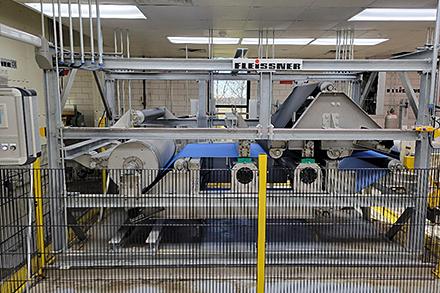Improving the Sustainability and Value of Cotton’s Natural Fibers

A “spunlacing” machine creates nonwoven cotton fabrics, such as wipes, diapers, and bandages. (Photo courtesy of Doug Hinchliffe)
Science May Boost the Cotton Nonwoven Industry and Clean the Environment
Humans have cultivated cotton and its fibers used as textiles for thousands of years. Now, researchers at the Agricultural Research Service’s (ARS) Southern Regional Research Center (SRRC) in New Orleans, LA, are looking to expand upon that utility, especially in the nonwoven market.
Nonwoven textiles differ from textiles that are woven or knitted in that nonwoven fabrics are constructed directly from loose fibers in a high-speed process. Nonwovens are mostly used for single-use disposable products such as wipes, diaper and adult incontinence components, feminine hygiene products, and disposable masks. They also find broad use in medical/healthcare applications, including bandages; dressings; and surgical gowns, drapes, and masks.
The United States is the world’s third-largest producer of cotton, and its leading cotton exporter. American farmers grow enough cotton in 17 states to provide about $21 billion to the U.S. economy each year. Science, however, is showing there’s room for even more economic impact.
“Cotton is natural, biodegradable, soft, and highly absorbent, making it an ideal fiber for next-to-skin nonwoven applications,” said Doug Hinchliffe, molecular biologist and research leader of SRRC’s Cotton Chemistry and Utilization Research unit. “Our project is unique in that we work on both pre- and post-harvest improvements to cotton fibers through genetics, breeding, and chemical modifications.”
Hinchliffe’s team is taking advantage of the natural variation of cotton fibers to identify varieties that are best suited for nonwoven textiles and offer such unique attributes as flame resistance and hydrogen peroxide generation. They’re even looking at incorporating metal nanoparticles into cotton fibers to achieve specific results.
“The functionality of nanoparticles depends on the type of metal we use,” he said. “For instance, silver or copper nanoparticles make the fabric antimicrobial. This type of durable antimicrobial finish has numerous uses, including disposable wipes, reusable rags for surface cleaning and sanitizing, athletic gear, and the liners of shoes to prevent bacterial growth and odor. Even upholstery or bedding.”
North American manufacturers created over five million tons of nonwoven materials in 2021, with about 70% being produced from natural fibers, like cotton, hemp, flax, and wool. There is, however, a catch: cotton accounted for less than 7% of these fibers, while synthetic fiber composed about 56% of the material. The problem, Hinchliffe said, is that synthetic fibers, like polyester and polypropylene (which are, essentially, plastics), persist in the environment for decades and contribute to pollution, especially in marine environments.
Consumers recognize this as an environmental hazard and are seeking greener, sustainable, and biodegradable products.
Nonwoven materials are created through a process called “spunlacing,” also known as hydroentanglement. Spunlacing uses a machine called an aquajet to control the weight and orientation of the fiber web it produces. As the web passes through the aquajet, very fine high-pressure water jets entangle the fibers with one another to provide structure and strength to the resultant fabric. Spunlace products are the fastest-growing type of nonwoven material and accounted for approximately 12% of all nonwovens consumed in 2019.
“As nonwovens production increases in North America – and globally – this is an excellent opportunity to increase the use of cotton fibers as a raw material,” Hinchliffe said. “This has the potential to benefit U.S. cotton growers through increased demand for cotton fibers and increased domestic consumption of cotton as a raw material.
“Market data shows that nonwovens tend to stay where they are produced, so you are looking at a domestic product made with fibers grown in the United States,” he said. “Farmers, producers, and consumers benefit from a natural and sustainable product and the environment benefits from less plastic pollution.” – Scott Elliott, ARS Office of Communications
Also in our Mardi Gras series:

